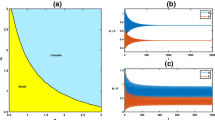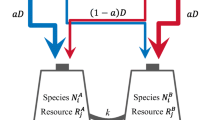Abstract
Metaecoepidemic models generalize metapopulation systems, combining local population dynamics with inter-patch migration coupled with an epidemic proliferation. A resource–consumer model is introduced with an ecosystem composed by two patches, in which consumers can freely move. A disease affects resources of the second patch. This situation corresponds to a grassland–herbivore environment, where one patch, managed in an extensive way, has a wider plant diversity, while the other one is highly fertilized leading to an important forage production. The latter is also subject to a fungal disease. Herbivores both feed on healthy or infected crop and can freely migrate between the two patches. A preliminary investigation focuses on behaviors emerging from some parts of the model, respectively, formed by uncoupled patches and by the purely demographic coupled model. Equilibria of the whole system are assessed and characterized. Results are then compared with the purely demographic model to highlight the role of the disease in this dynamics. A thorough numerical investigation of the model completes this analysis to assess the system behavior near each equilibrium. System bifurcations have also been explored as well as the response of the system equilibria to parameter perturbations. The disease eradication is possible under suitable circumstances. Coexistence of the five populations through persistent oscillations is also possible, but it is not at a stable level.


























Similar content being viewed by others
References
Bianco F, Cagliero E, Gastelurrutia M, Venturino E (2012) Metaecoepidemic models: infected and migrating predators. Int J Comp Math 89(13–14):1764–1780
Chattopadhyay J, Arino O (1999) A predator–prey model with disease in the prey. Nonlinear Anal 36:747–766
Dengler J, Janišová M, Török T, Wellstein C (2014) Biodiversity of Palaearctic grasslands: a synthesis. Agric Ecosyst Environ 182:1–14. https://doi.org/10.1016/j.agee.2013.12.015
Edelstein-Keshet L (2005) Mathematical models in biology. SIAM, Class Appl Math 46:1–586
Gaujour E, Amiaud B, Mignolet C, Plantureux S (2012) Factors and processes affecting plant biodiversity in permanent grasslands. A review. Agron Sustain Dev 32(1):133–160. https://doi.org/10.1007/s13593-011-0015-3
Gillet F (2008) Encyclopedia of ecology: ecological plant competition, vol 2783-2793. Elsevier, Amsterdam
Humbert JY, Dwyer JM, Andrey A, Arlettaz R (2016) Impacts of nitrogen addition on plant biodiversity in mountain grasslands depend on dose, application duration and climate: a systematic review. Glob Change Biol 22(1):110–120. https://doi.org/10.1111/gcb.12986
Kang Y, Sasmal SK, Messan K (2017) A two-patch prey–predator model with predator dispersal driven by the predation strength. Math Biosci Eng 14(4):843–880
Kareiva P (1990) Population dynamics in spatially complex environments: theory and data. Philos Trans R Soc Lond B 330:175–90
Kipling R, Virkajärvi P, Breitsameter L, Curnel Y, De Swaef T, Gustavsson A, Hennart S, Höglind M, Järvenranta K, Minet J, Nendel C, Persson T, Picon-Cochard C, Rolinski S, Sandars D, Scollan N, Sebek L, Seddaiu G, Topp C, Twardy S, Van Middelkoop J, Wu L, Bellocchi G (2016) Key challenges and priorities for modelling European grasslands under climate change. Sci Total Environ 566–567:851–864
Malchow H, Petrovskii S, Venturino E (2008) Spatiotemporal patterns in ecology and epidemiology. CRC, Boca Raton
Mauchamp L, Mouly A, Badot P-M, Gillet F (2016) Impact of nitrogen inputs on multiple facets of plant biodiversity in mountain grasslands: does nutrient source matter? Appl Veg Sci 19(2):206–217. https://doi.org/10.1111/avsc.12214
McCann KS (2000) The diversity–stability debate. Nature 405:228–233
Mitchell CE, Tilman D, Groth JV (2002) Effects of grassland plant species diversity, abundance, and composition on foliar fungal disease. Ecology 83(6):1713. https://doi.org/10.2307/3071990
Oliver TH, Heard MS, Isaac NJB, Roy DB, Procter D, Eigenbrod F, Freckleton R, Hector A, Orme CDL, Petchey OL, Proença V, Raffaelli D, Suttle KB, Mace GM, Martin-Lopez B, Woodcock BA, Bullock JM (2015) Biodiversity and resilience of ecosystem functions. Trends Ecol Evol 30(11):673–684. https://doi.org/10.1016/j.tree.2015.08.009
Siehoff SG, Lennartz G, Heilburg I, Ross-Nickoll M, Ratte H, Preuss T (2011) Process-based modeling of grassland dynamics built on ecological indicator values for land use. Ecol Model 222(23–24):3854–3868
Van Oijen M, Bellocchi G, Höglind MM (2018) Effects of climate change on grassland biodiversity and productivity: the need for a diversity of models. Agronomy 8(2):14
Venturino E (2011) Simple metaecoepidemic models. Bull Math Biol 73(5):917–950
Venturino E (2016a) Metaecoepidemic models with sound and infected prey migrations. Math Comput Simul 126:14–44. https://doi.org/10.1016/j.matcom.2016.02.006
Venturino E (2016b) Ecoepidemiology: a more comprehensive view of population interactions. Math Model Nat Phenom 11(1):49–90
Wiens JA (1996) Wildlife in patchy environments: metapopulations, mosaics, and management. In: McCullough DR (ed) Metapopulations and wildlife conservation. Island Press, Washington, pp 53–84
Wiens JA (1997) Metapopulation dynamics and landscape ecology. In: Hanski IA, Gilpin ME (eds) Metapopulation biology. Academic Press, San Diego, pp 43–62
Wilson JB, Peet RK, Dengler J, Pärtel M (2012) Plant species richness: the world records. J Veg Sci 23(4):796–802. https://doi.org/10.1111/j.1654-1103.2012.01400.x
Yachi S, Loreau M (1999) Biodiversity and ecosystem productivity in a fluctuating environment: the insurance hypothesis. Proc Nat Acad Sci USA 96(4):1463–1468. https://doi.org/10.1073/pnas.96.4.1463
Acknowledgements
This research was undertaken within the framework of the Epimath project, funded by Region Bourgogne Franche-Comté.
Author information
Authors and Affiliations
Corresponding author
Additional information
Publisher's Note
Springer Nature remains neutral with regard to jurisdictional claims in published maps and institutional affiliations.
Ezio Venturino–Member of the research group GNCS.
Rights and permissions
About this article
Cite this article
Moulin, T., Perasso, A. & Venturino, E. A Metaecoepidemic Model of Grassland Ecosystem with Only Consumers’ Migration. Bull Math Biol 82, 88 (2020). https://doi.org/10.1007/s11538-020-00764-5
Received:
Accepted:
Published:
DOI: https://doi.org/10.1007/s11538-020-00764-5




